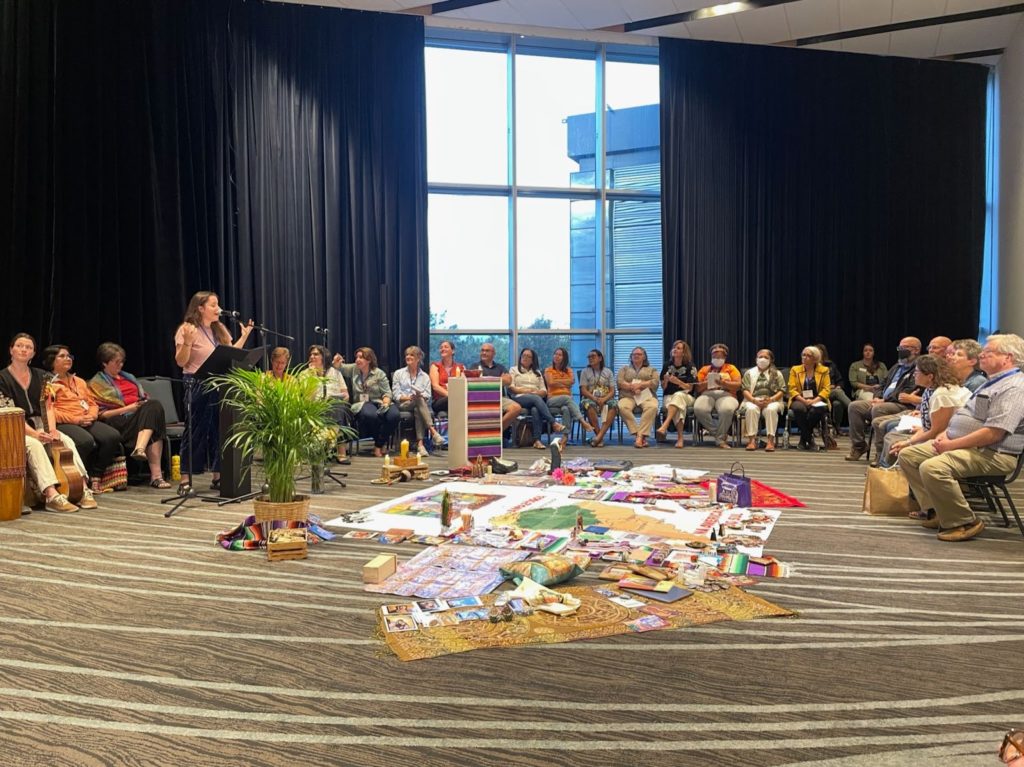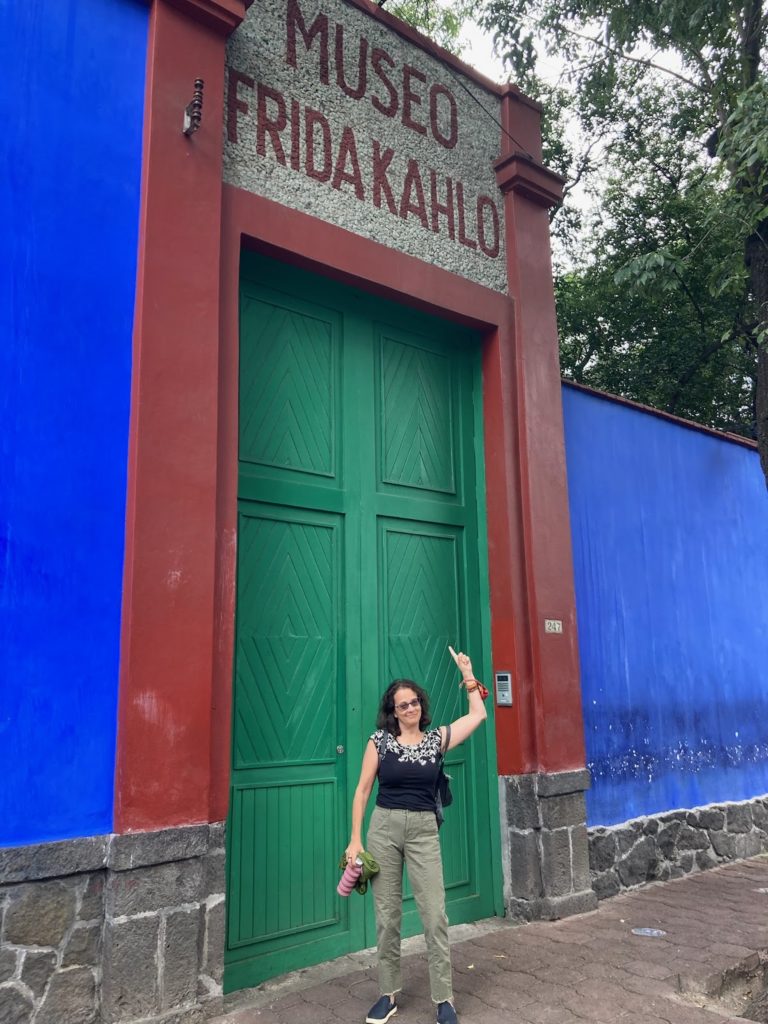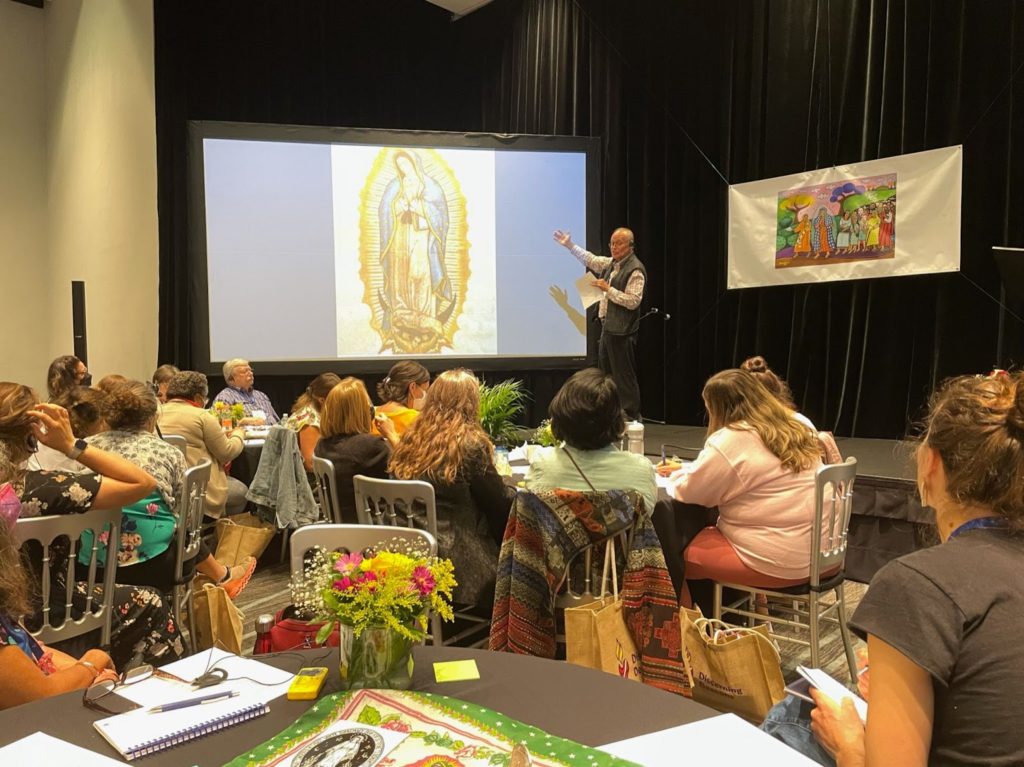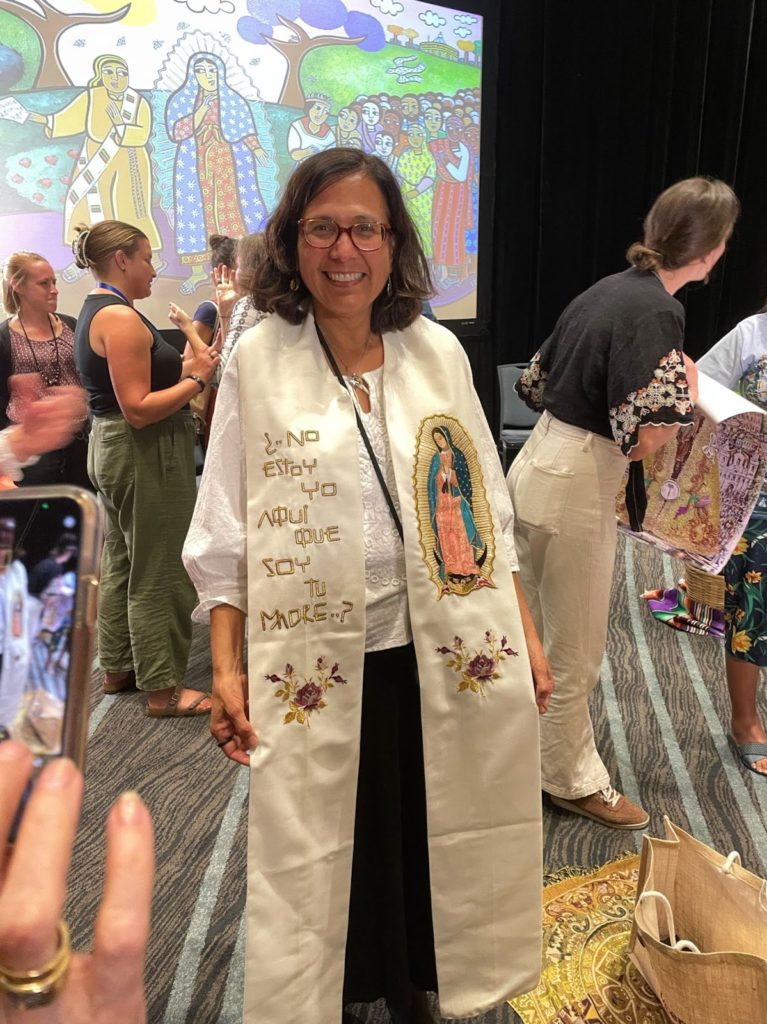A Conversation with Jane and Lizzie
Jane Varner Malhotra and Lizzie Berne DeGear are both members of WOC, and this summer we were introduced to each other by Kate McElwee just before heading to Mexico City on pilgrimage with Discerning Deacons. A few zoom calls in the weeks before the trip had us bonding on everything from questions over what to pack to what it feels like to be a woman called to Catholic priesthood. The pilgrimage forged a friendship that continues to bloom. Here we converse about some of what we learned and experienced together.

Lizzie: Coming into this, we had never met each other in person, or anyone else among the sixty pilgrims, right? Except our mutual friend, Liz McCloskey. It was like diving into a whole new community for five days. I felt like I was always balancing the invitation to enjoy a really rich collective experience with my own need for introverted moments and solitude. What was it like for you?
Jane: Well, I enjoyed the people I met and I loved hearing their stories. I loved the way the music brought us together as a community – all that singing on the tour bus! – and I was surprised how soon I found myself happily singing along in Spanish. And the Brazilian contingent! Even though I don’t speak Portuguese, I just enjoyed their positive energy from the start. I loved the liturgy they organized, celebrating solidarity with the poor and with nature, and how they encouraged us all to use our voices for those who don’t get the microphone, so to speak. They also found a way to involve us all in the liturgy in different ways, like processing in while holding images of martyrs who gave their lives to protect the Amazon. Very moving.

Jane cont’d: But, yes, we all benefit from alone time. I debated requesting my own room but when you told me you had done it, I was inspired to do it too and give myself that space. There were 60 new friends on the trip–it helped balance the socializing and community building. So thanks for that!
Lizzie: Yeah, I really needed those moments to myself in order to process and absorb everything that we got to experience on that trip. And speaking of thanks… I wouldn’t have gotten to the Frida Kahlo museum if it wasn’t for you! I can’t tell you how grateful I was when you took the initiative and made that happen. And that ended up being one of the most meaningful, spiritual experiences of the pilgrimage for me even though it wasn’t on the itinerary.
Jane: Yes, for me too. And we really had to work to get inside those beautiful blue walls of Casa Azul, didn’t we? I don’t know how to describe that color to somebody who hasn’t seen it, but it was deeper-than-the-sky blue, brighter-than-the-sea blue. Maybe cobalt.

Jane cont’d: Seeing Frida Kahlo’s studio, just as she had left it, that’s when I knew I had come to the right place. As an artist, seeing people’s brushes and their easel and where the light comes in, that always speaks to me. Being in the place where Frida created, I really felt this was where Guadalupe was inviting me to come for the afternoon.
Lizzie: I had that moment too! For me it was when we walked into the exhibit and I learned that Frida Kahlo’s first name was Magdalena. Guadalupe and Mary Magdalene came together in a powerful way in that moment and I felt their mutual presence. In fact, I felt more connected to Guadalupe when I was at Casa Azul than when we were at the shrine dedicated to her. At the shrine I was glad to see how much the place means to so many people, but in the moment, I couldn’t get past all the cement and highly pruned shrubbery.
Jane: I know what you mean. It felt a little too boxed in for what Our Lady of Guadalupe is. If I think about where I encountered her on the trip, I’d say it was more in the sunrise over the mountains in the early morning.
Lizzie: Yes! That mountain air and that sun. I felt that too. That reminds me of something Fr. Eleazar [Eleazar Hernandez Lopez, the indigenous theologian and diocesan priest who spoke to our group] said. That when indigenous people see the image of Guadalupe/Tonantzin on the tilma, they see the sun divinity in its female aspects. The sun goddess!
Speaking of priests, how has this pilgrimage been shaping your priesthood?
Jane: Good question. Well, as I said, I really enjoyed all the music on this trip, and that made me realize in my own community in DC, we haven’t been putting enough value on music at our liturgies. [Jane is the co-founder of WHIMM – Washington Home Inclusive Monthly Mass] I’ve come back to DC with a renewed emphasis on that and our next Mass this weekend is going to have really good music. And I’m excited about that.
How about you? How has it touched your work as a priest?
Lizzie: Well, the Sunday after our trip I was scheduled to preside at a women’s liturgy that I attend every month. On Zoom of course, since the pandemic started. A different woman volunteers to create and lead the liturgy each month, and this was my turn. I was psyched to bring some of this new connection to Guadalupe and new-to-me indigenous theology back to my sisters. It was challenging, but I loved weaving these new experiences and ideas into a eucharistic celebration. I think it made for a powerful gathering.
Jane: There’s so much to harvest from a trip like this one, in another country, on a sacred journey, with a group of changemakers. What else stands out for you as you gather the graces?
Lizzie: Oh, I love that image of gathering the graces. I think of the way that in the legend, Cuauhtlatoatzin [whom the Spaniards named Juan Diego when he was baptized in his 50s] is told by Guadalupe to gather the flowers from the hill where they encounter each other, and he gathers them in his garment, carries them like that for miles, and then releases them in the presence of the Franciscan priest who was acting as colonial archbishop. The way those flowers interacted with the folds in his tilma is what created the image of Guadalupe that folks still venerate today. Talk about gathering the graces! And – I know this may sound weird – but it’s the actual folds and gathers in Guadalupe’s garment that have been the source of a lot of graces for me. Something you told me about those folds allowed a whole new channel of grace to flow. You came back from the trip and were sharing the image of Guadalupe with someone who was uncomfortable with what he saw–
Jane: Yes! He said he saw a figure of a naked woman in the fabric.
Lizzie: I couldn’t believe it! And then, once I saw the woman’s bare torso in the folds of Guadalupe’s garment, just where her left knee bends,I couldn’t un-see it.

Lizzie cont’d And I know that many might feel that vaginas are not a polite topic of conversation, but the symbolic vagina – in all its power – has been one of the graces that I’ve been receiving since this trip. Vaginas everywhere! They’ve been there all along, but it’s like I’m experiencing the truth and power of that symbol in a new way. Just yesterday, I came across my notes from a WOC event in 2019 with Joan Chittister and Teresa Forcades.
Jane: I was at that event! An unforgettable dialog.
Lizzie: Really? Of course you were! So we met before we even met. I love that. Remember, Forcades [Spanish theologian, Benedictine nun and medical doctor] talking about how John’s gospel refers to Christ nestled into the folds of God? [John 1:18] And she pointed out that the Greek word in the text that describes these folds is kolpos, which is the medical word for….
Jane: Vagina!
Lizzie: Preach the word! Oh, and speaking of preaching, as a group we celebrated many Masses during the few days of our pilgrimage. The way the sacrament came through the women who planned and voiced and preached these Masses birthed many graces for me.
Jane: Me too. At first I was a little daunted by the fact that there were four masses in five days, but then I realized women were planning and leading these beautiful, creative liturgies, so we were taking every opportunity to make visible the ministerial gifts of all who are called. In fact, I’m surprised there weren’t five masses!
Lizzie: It was pretty incredible to meet a new friend over dinner – I’m thinking of Lydia Tinajero-Deck, a doctor from San Francisco – and then to be at Mass at that beautiful 18th-century chapel on the grounds of Our Lady of Guadalupe’s shrine and to see Lydia ascend to the altar and to listen to her preach. Such holy wisdom! I wept. Any new friendships stand out for you?

Jane: In addition to the inspiring women from Brazil, there was a strong showing from Minnesota too, where my dad is from and where my mom’s mother grew up. These women are doing diaconal and priestly work in their parishes, in part because they have a supportive bishop. One of the women was also named Jane, and we became friends during a long bus ride together. And I learned the Spanish word tocayo: name-buddy! I was really grateful for the many bilingual people on the trip who helped bridge language gaps for us, too. Ellie [Hidalgo, co-founder of Discerning Deacons] had a name for this work but I can’t remember it. Something like “cultural navigators.”
Lizzie: Speaking of building bridges, let me ask you, what was it like coming out on this trip as a woman seeking ordination?
Jane: I wasn’t sure how folks on the trip would respond when I told them I was seeking ordination as a priest rather than deacon. But the first person I shared this with, a parish leader in Boston, said “Fabulous! Send me an invite to your ordination and I’ll be there.” It was heartening to know I was among supportive people. She said she often attends mass with a womanpriest in her area, and that she’s open about it at her church. I do think the women priesthood movement suffers a little from the many years when it was forbidden to discuss it. A chilling effect that can be hard to shake off.
Lizzie: Yes, maybe that’s connected to why Catholics feel so uncomfortable even saying ‘vagina’. I think being able to talk with each other, as priests, during the trip helped manage that effect. I remember nudging you to say something during our Feast of St. Phoebe celebration on the second-to-last night of the trip, and you saying you had to wait til the moment felt right. And you sure found the right moment! Can we talk about your toast on the last evening? When all of the pilgrims were gathered for our last meal together?
Jane: Well, part of why I became involved in this movement is following the example of my aunt Anne Patrick, a theologian who helped organize the first Women’s Ordination Conference in Detroit in 1975. A group of people chose that moment as part of the International Year of the Woman to launch a global effort to prepare for the inevitable day when women would be ordained. So in her memory, and in honor of all who have been working on this effort for hundreds of years really, to give women equal dignity in the church, and inclusion in all ministerial roles–I invited our group to raise a glass. Because we are part of that ongoing project, standing on the shoulders of many incredible people who dedicated their lives to this.

Lizzie: I remember all the love and grace that was pouring towards you as you gave that toast. It was beautiful. I felt your aunt’s presence, and all the ancestors of this movement –of these multiple movements! – stretching back in time and encouraging us forward.
Jane: Amen!

2 Responses
This is so rich! Thanks for sharing so many aspects of your experience, on the trip and before. I hope you continue talking with us as well as with each other.
Thank you, Jane, for calling to my memory dear Anne Patrick . The cloud of witnesses, the communion of saints–she is for me one of the most amazing presences in my life. I knew her through a mutual friend, Avis Allmaras, and we had the amazing gift of a winter weekend at the end of January since 1982 that brought laughter, food, incredible sharing and learning how to grow in wisdom. Peace, Maureen O’Connor